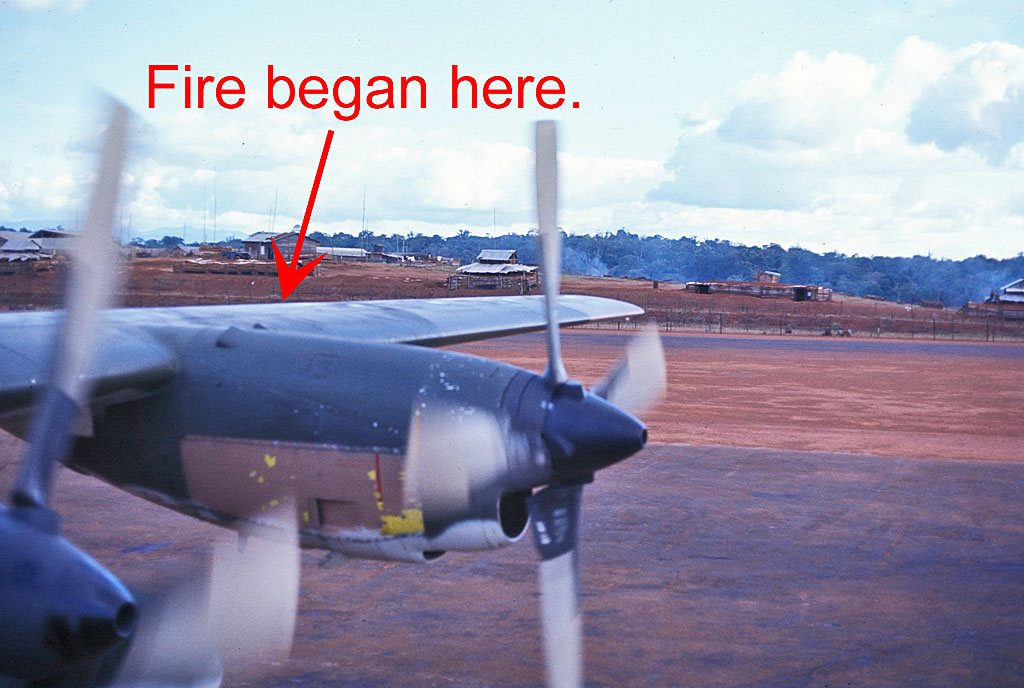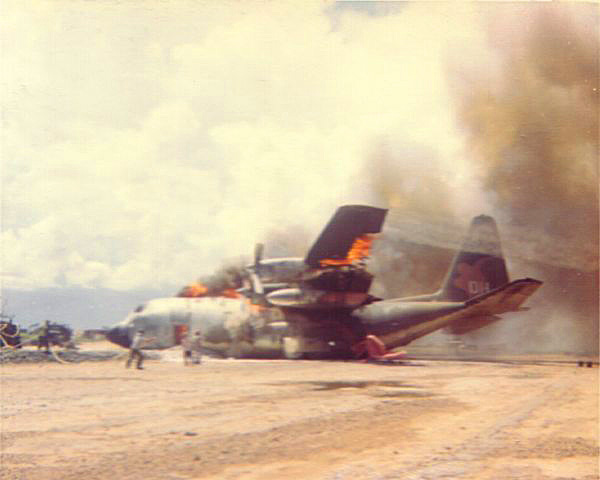Fire in Flight – Page 4.
Simultaneously, out of the corner of my eye, I noticed a fire on the left wing and as I looked out I saw that the #1 engine was completely engulfed in flames. I said something like, "Number one's on fire and I'm shutting it down." The correct procedure is to have the copilot actually perform the steps as the AC calls them out, but I didn't want to waste any time, so I reached for the fire emergency control handle, pulled it, and moved the condition lever to the "feather" position. This streamlines the prop so that it won't windmill and cause drag. I called for the #1 fire bottle and Britt reached up and fired the first fire bottle. As he did that, I turned to observe the effect on the #1 engine. The fire went from engulfing the engine to just coming out of the outlets and louvers in the cowl. It was still burning pretty severely, so I called for the second fire bottle. When Britt fired it, the engine fire went completely out.
Here's were things started to get dicey. Extinguishing the engine fire revealed the potentially fatal fire beyond, and no amount of fire extinguisher was going to get this one out. There was a raging fire out on the wing, outboard of the #1 engine and obviously burning into the fuel tank. The full weight of the reality that this airplane was critically damaged flowed into my consciousness. It was like a sucker punch to the gut, that sick feeling you get when you realize perhaps you are not going to survive this one. One minute you think you have things under control, you are confident you are going to be able to work yourself out of the problem, then, all of sudden, you are no longer in control. The events have taken over and you become painfully aware of the responsibility you have to get these crew members safely on the ground--but failure seems imminent.
The photo on the left illustrates the pilot's view of the left wing. The arrow indicates the location of the wing fire when I first saw it just outboard of the number 1 engine.
My immediate thought was the wing was either going to blow or parts would start to burn off and render the aircraft uncontrollable. Thankfully, the rest of the cockpit crew could not see what I was seeing. If they had been able to, it would have been extremely distracting to say the least. The fire was burning starting at the wing trailing edge near where the aileron and flaps intersect, being fed by a 200-mph blast of oncoming air, and it was cutting through the wing like a giant blowtorch. You can get an idea of what I was seeing by looking at the photo below.
This photo is out of sequence, but I include it here so you can visualize what I was looking at in flight. It was taken shortly after the crew had exited and the fire trucks had just arrived. But the wing fire is pretty much the way it was in flight. If you look at the wing trailing edge, you will notice that part of the flaps and aileron are gone. The aileron starts about halfway between the outboard engine and the wingtip. The flap extends all the way from the fuselage to the aileron. So about half of the aileron and about 1/3rd of the flap are missing. Notice the finger of flame that extends forward towards the leading edge. This was the blowtorch that I was looking at from the cockpit out over the top of the wing. Here, it looks like the fire has cut through the main spar and only the forward spar remains intact. In flight, it looked to me like the blowtorch had cut through the trailing edge spar and was approaching the main spar, but you can look at the photo above and visualize what the lift on that outboard section of wing was doing to the remaining structure. As I said, it looked like the entire outboard section was bending up and twisting such that the trailing edge was moving up. The only person on the crew that had a good view of the fire from the bottom of the wing was the loadmaster, Jerry Willard.

